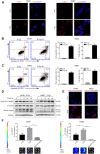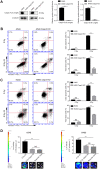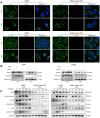Caspase-3 knockout attenuates radiation-induced tumor repopulation via impairing the ATM/p53/Cox-2/PGE2 pathway in non-small cell lung cancer
- PMID: 33180744
- PMCID: PMC7695367
- DOI: 10.18632/aging.103984
Caspase-3 knockout attenuates radiation-induced tumor repopulation via impairing the ATM/p53/Cox-2/PGE2 pathway in non-small cell lung cancer
Abstract
Radiotherapy is an effective treatment for non-small cell lung cancer (NSCLC). However, irradiated, dying tumor cells generate potent growth stimulatory signals during radiotherapy that promote the repopulation of adjacent surviving tumor cells to cause tumor recurrence. We investigated the function of caspase-3 in NSCLC repopulation after radiotherapy. We found that radiotherapy induced a DNA damage response (DDR), activated caspase-3, and promoted tumor repopulation in NSCLC cells. Unexpectedly, caspase-3 knockout attenuated the ataxia-telangiectasia mutated (ATM)/p53-initiated DDR by decreasing nuclear migration of endonuclease G (EndoG), thereby reducing the growth-promoting effect of irradiated, dying tumor cells. We also identified p53 as a regulator of the Cox-2/PGE2 axis and its involvement in caspase-3-induced tumor repopulation after radiotherapy. In addition, injection of caspase-3 knockout NSCLC cells impaired tumor growth in a nude mouse model. Our findings reveal that caspase-3 promotes tumor repopulation in NSCLC cells by activating DDR and the downstream Cox-2/PGE2 axis. Thus, caspase-3-induced ATM/p53/Cox-2/PGE2 signaling pathway could provide potential therapeutic targets to reduce NSCLC recurrence after radiotherapy.
Keywords: DNA damage response; caspase-3; non-small cell lung cancer; radiotherapy; tumor repopulation.
Conflict of interest statement
Figures







Similar articles
-
CB11, a novel purine-based PPARɣ ligand, overcomes radio-resistance by regulating ATM signalling and EMT in human non-small-cell lung cancer cells.Br J Cancer. 2020 Dec;123(12):1737-1748. doi: 10.1038/s41416-020-01088-w. Epub 2020 Sep 22. Br J Cancer. 2020. PMID: 32958825 Free PMC article.
-
Attenuation of the DNA damage response by transforming growth factor-beta inhibitors enhances radiation sensitivity of non-small-cell lung cancer cells in vitro and in vivo.Int J Radiat Oncol Biol Phys. 2015 Jan 1;91(1):91-9. doi: 10.1016/j.ijrobp.2014.09.026. Int J Radiat Oncol Biol Phys. 2015. PMID: 25835621
-
Metformin inhibits growth and enhances radiation response of non-small cell lung cancer (NSCLC) through ATM and AMPK.Br J Cancer. 2013 May 28;108(10):2021-32. doi: 10.1038/bjc.2013.187. Epub 2013 Apr 30. Br J Cancer. 2013. PMID: 23632475 Free PMC article.
-
The paradox role of caspase cascade in ionizing radiation therapy.J Biomed Sci. 2016 Dec 7;23(1):88. doi: 10.1186/s12929-016-0306-8. J Biomed Sci. 2016. PMID: 27923354 Free PMC article. Review.
-
Cyclooxygenase-2: A Role in Cancer Stem Cell Survival and Repopulation of Cancer Cells during Therapy.Stem Cells Int. 2016;2016:2048731. doi: 10.1155/2016/2048731. Epub 2016 Nov 1. Stem Cells Int. 2016. PMID: 27882058 Free PMC article. Review.
Cited by
-
TOPAS-Tissue: A Framework for the Simulation of the Biological Response to Ionizing Radiation at the Multi-Cellular Level.Int J Mol Sci. 2024 Sep 19;25(18):10061. doi: 10.3390/ijms251810061. Int J Mol Sci. 2024. PMID: 39337547 Free PMC article.
-
Network Pharmacology and Molecular Docking Study on the Mechanism of the Therapeutic Effect of Strychni Semen in NSCLC.Biol Proced Online. 2024 Dec 31;26(1):33. doi: 10.1186/s12575-024-00259-w. Biol Proced Online. 2024. PMID: 39736533 Free PMC article.
-
Biophysics at the edge of life and death: radical control of apoptotic mechanisms.Front Cell Death. 2023;2:1147605. doi: 10.3389/fceld.2023.1147605. Epub 2023 Feb 26. Front Cell Death. 2023. PMID: 39897412 Free PMC article.
-
Lung cancer progression alters lung and gut microbiomes and lipid metabolism.Heliyon. 2023 Dec 9;10(1):e23509. doi: 10.1016/j.heliyon.2023.e23509. eCollection 2024 Jan 15. Heliyon. 2023. PMID: 38169741 Free PMC article.
-
Role of Mitochondria in Radiation Responses: Epigenetic, Metabolic, and Signaling Impacts.Int J Mol Sci. 2021 Oct 13;22(20):11047. doi: 10.3390/ijms222011047. Int J Mol Sci. 2021. PMID: 34681703 Free PMC article. Review.
References
Publication types
MeSH terms
Substances
LinkOut - more resources
Full Text Sources
Medical
Research Materials
Miscellaneous

